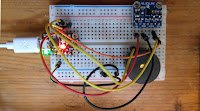A concise solution to a fiddly coding problem

I My pomodoro timer is coming on nicely. I'll post about progress in the next day or so. For now, here is a short story about a problem I hit while working on the project, and the happy solution that I came up with. For some time I've kept an online journal for each project I'm working on. Like some blogs, the journals used to have the latest entries at the top. Here's a sample journal file: # Project journal for zero-web ## Thursday 07 February 2019 I added 2 new pages. ## Monday 04 February 2019 I've created a homepage. I'll serve it with websocketd. I found that order confusing. I decided that I'd prefer the posts ordered as they would be in a paper diary, with the latest posts last. That way I could read the project history like a book. The problem: I have a lot of project journals, and I really didn't want to edit them all by hand. I decided to write a program to do it. The problem was simple to solve using APL. Regul